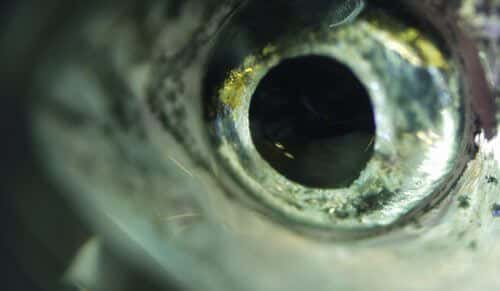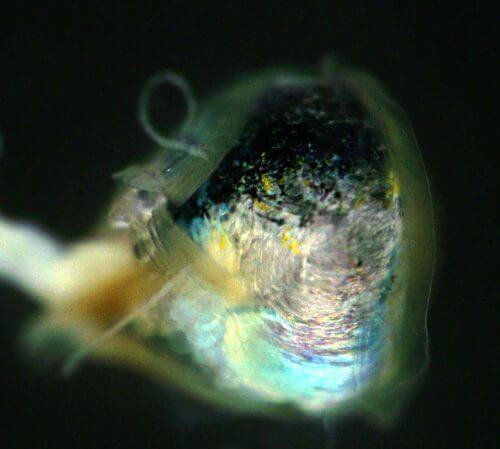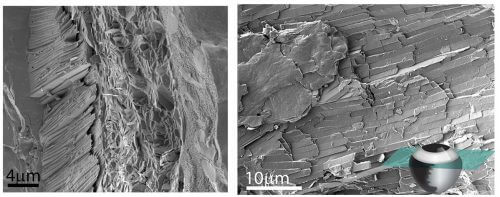The iris of the zebrafish has a unique crystalline structure that has a dual function: camouflage and prevention of the entry of unwanted light. Understanding the way in which fish control iris development may help treat diseases such as gout or kidney stones

The father of the theory of evolution, Charles Darwin, humbly admitted that the development of such a miraculous organ as the eye was a puzzle in his eyes. Today we know that this is one miracle among many: evolution has "created" many and varied vision systems, many of which even challenge the sophistication of our eyes. A new study by Weizmann Institute of Science scientists, recently published in the scientific journal Advanced Science, focuses on one of those sophisticated vision systems, and illustrates the great precision and complexity that have developed in the iris of the zebrafish.
Dr. Dvir Gore studied the visual system of the zebrafish as part of a post-doctoral study that brought together two of the institute's scientists - Prof. Gil Lebkowitz from the department of molecular biology of the cell, and Prof. Dan Oron from the department of physics of complex systems: Prof. Lebkowitz studies the development of the nervous system of Zebrafish, and Prof. Oron specializes in materials that absorb and scatter light. Through a combination of forces, the researchers were able to discover how the outer, silvery layer of the fish's eyes is constructed, and how it works. "The iris, both ours and the zebrafish, blocks the light that hits the eye, except for the rays that pass through the pupil to the lens and retina," says Dr. Gore. "The iris of our eye contains the pigment melanin, which absorbs light, and its concentration in the iris also determines the color of the eye. In zebrafish, on the other hand, the iris reflects light similar to a mirror, and in the process also masks the fish's eyes, which protrude from the sides of its head. We wanted to understand how the iris performs both functions - both blocking unwanted light and camouflage."

To this end, the researchers first used the computerized micro-tomography (microCT) system at the institute, and in this matter they were assisted by the faculty scientist, Dr. Wald Brumfeld. This is how they wanted to get an overall picture of the structure of the eye. Later, the researchers focused on sections of the iris using a scanning electron microscope (cryo-SEM). The researchers expected to find a layer of guanine crystals, the substance that is also used as one of the building blocks of DNA. When guanine is in its crystalline form, it is transparent, but the thin crystalline plates of guanine, arranged in layers, reflect light, and usually create a silvery or luminous appearance. In fish, in their skin and scales, there are crystals of guanine, and they are produced by special cells called iridophores.
And so, in accordance with their expectations, the researchers found that the outer layer of the iris is indeed paved with thin guanine crystals. However, they were surprised to discover two additional layers: a middle layer consisting of disordered crystals, and a very thin inner layer containing melanin, the same light-absorbing pigment found in the iris of the human eye. Each of these layers on its own can prevent unfocused light from being projected onto the retina. And if so, what is the evolutionary logic in the existence of all three together? Computer simulations and optical measurements, carried out together with Amri Bar-Eli from Prof. Oron's research group, helped the scientists discover the answer. The outer and organized layer reflects light mainly in blue and green wavelengths; These are of course the main wavelengths of light under the surface of the water, and are the most suitable for camouflaging the fish's eye. The second layer scatters the light, and the third layer, located in the inner part of the iris, acts as a kind of "black screen" that absorbs the light rays that managed to slip through the other two layers.

Observations on the development of the iris throughout the life of the fish added another layer to the understanding of how the eyes work. The researchers discovered that just a few days after the fry hatches from the egg, the ordered crystalline layer of the iris appears, while the disordered layer develops only later. Computational simulations conducted by the researchers indicated that a thin layer of crystals can block 3 times more light than a melanin layer of similar thickness. Therefore, this layer is especially useful for the tiny eyes of a newborn minnow, which must quickly distinguish between predators and prey, as its eyes continue to develop at a rapid pace.
To further deepen the acquaintance with the fish eye and examine the structure of its iris, the researchers traveled to Switzerland, to examine it at the European Synchrotron Radiation Facility (ESRF). Prof. Oron explains: "Focusing on the nanometer scale and very fast scanning using synchrotron x-ray crystallography allowed us to obtain an image of the entire iris, and not just segments, with incredible resolution." In collaboration with Dr. Jan-David Nicolas, from the University of Göttingen in Germany, the research group analyzed a huge amount of scan data, and discovered another surprise: the crystal "tiles" in the outer layer - which are thin and long hexagonal - as if they were placed by the hands of a master sequencer along the entire length, when they are all located in the same precisely, and their angle changes with the curvature of the eye. This way the entire iris looks silvery, and at the same time also protects the edges of the eye and the areas closest to the lens from the sunlight coming from above.
Dr. Gore, who is currently conducting additional post-doctoral research at the Genelia Campus of the Howard Hughes Medical Institute and the National Institutes of Health (NIH) in the United States, says that these findings have significance for humans as well. These days he is testing whether understanding the way in which the fish control the development of crystals in their eyes and skin may help treat diseases such as gout or kidney stones, where crystals of a similar substance (uric acid) form in places where they are not wanted. "Sometimes, ancient evolutionary solutions may pave the way for new solutions," says Dr. Gore.
"It took a structural chemist, a biologist, a physicist, and a combination of different and varied methods to reach the results of this research," Prof. Lebkowitz concludes. "Without each of them, we would not have been able to understand the evolution of this complex system."
The length of the zebrafish that hatches from the egg 72 hours after fertilization is 3.5 mm.

2 תגובות
"The father of the theory of evolution, Charles Darwin, humbly admitted that the development of such a wonderful organ as the eye was a puzzle in his eyes."
That is not true at all!!! That's not what he said!!!
Darwin said - "To assume that the eye... evolved by natural selection is apparently (!) absurd."
And he continued - "But logic tells me that if we find a multi-step route from a modern eye to a primitive and simple eye... then you can't say that the difficulty is real".
Darwin did not know the whole process. Today we know that there is a pathway from a simple light-sensitive molecule to the best eyes (birds of prey, mantis shrimps, cats and even goats).
"We know that this is one miracle among many: evolution has "created" many and varied vision systems"
This evolution is really, really smart and also knows how to do wonders. Kudos to evolution.